
In July 2015 we got the amazing chance to be part of the crew on a small sailing vessel sailing from Baltimore to Alaska, via The North West Passage and Greenland. Only about 135 small vessels (under 20m) have ever completed this passage and when you set off the chances of the sea ice in the north of Canada actually melting to let you through is 50/50. That’s if you even make it up past Greenland. Below is my story of sailing the north west passage! 

Our route through the Northwest Passage
The captain of the yacht found us on a crew-finding website Latitude 38 where we had put up a small advertisement describing ourselves and expressing interest in being crew on a sailing yacht on a shared expense deal. There are people all over the world doing this; you crew for free and sometimes share expenses in exchange for amazing experiences and not having to buy your own yacht. Our captain needed 4 crew to help him sail the yacht as it wouldn’t be safe for him to do it alone.

Our yacht, SV Hawk
Specifications
Length: 12.8m, 47 Feet,
Beam: 4.5m, 15 Feet,
Draft: 2.1m, 7 Feet,
Mast: 23m,
Ballast: 6.3 Tonne, 14000lb,
Weight: 15 tonnes, 30 000lb
75 feet, Motor: 75 Hp,
Sail Area: 120 Sqm, 1300 SqFeet,
Hull: 8mm Aluminium, 1/3”,
Insulation: 8cm, 3” foam
Sails: Main, Jib, Stay, Storm Jib, Blast Reacher
Fuel Capacity: 750L, 200 Gallons, Water Capacity: 750L, 200 gallons
Heater: Diesel drip, Engine fan
Cruising speed under engine: 6 kt, Max sailing speed: 9 kt
SV Hawk is a well-proven sailing vessel. It has circumnavigated the globe with previous owners Beth and Evan. You can read more about their adventures on the blog they kept for many years. It was designed to be strong with a hull of 8mm aluminium, 3 inches of insulation on the inside, a diesel heater and large water and fuel storage. It easily sleeps 4 people, but as we had 5 the captain, Joe Wolfe slept on the couch/settee area.
We met the yacht in Cypress Marine on 10th July 2015, jet-lagged from our terrible flight from Malaysia where I had to go to get an American tourist visa. As I would be entering the USA in Alaska on a private yacht my ESTA visa waiver wouldn’t work.
Over the next 10 days we prepared the yacht for departure. All-in-all we spent around $10,000 on food for the expected 3 month passage, with an extra month or 2 of spare food in case we encountered problems.

The view from the top of the mast
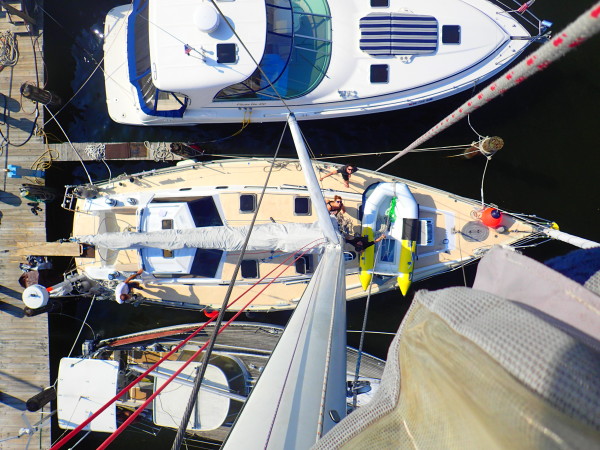

Checking the rigging before setting sail

The navigation station with food storage behind

The settee area.

The galley
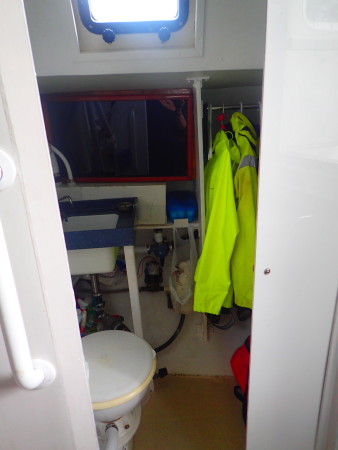
The head (toilet)

Cramming spare gear into the sail locker

Gracie and I had a double bed. Very comfortable until you start sailing as the whole boat is on a 20 degree lean for several days. The person on top spends the whole time trying to stay at the top of the bed!
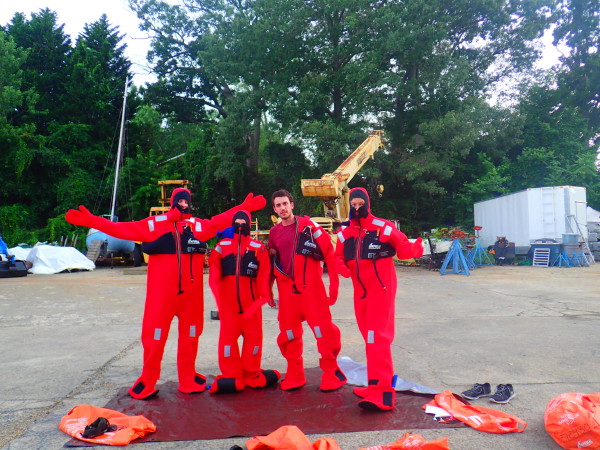
Practicing with immersion suits in 35°C




$2500 of groceries

This is what $2500 of groceries looks like. Just the start
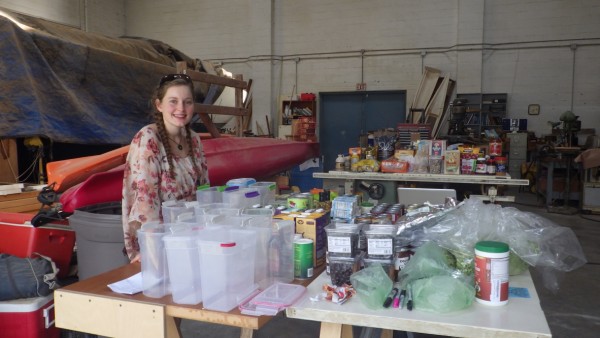
 Shopping list
Shopping listHere’s a few of the things that were on our shopping list along with many more items. The hardest thing was fitting it into all the small spaces and cubbyholes throughout the boat.
1100 eggs, 20 cabbages, 25kg potatoes, 20kg onions, 15 pumpkins, 20kg carrots, 80 cans tuna, 60 cans salmon, 60 cans chicken, 80 cans olives, 100 cans tomatoes, 15L almond butter, 10kg bacon, 25kg cheese, 5kg butter, 60 cans of milk, 10 loaves of bread, 8kg crackers, 100 apples, 60 oranges, 15kg salami, 25kg oats, 25kg rice, 30kg pasta, 30kg flour, 40kg fruit and nuts

Coming out of Delaware Bay.

Bailimore to Halifax
Our first 3 days were absolutely horrible. We came out into the end of a tropical storm and with 45 knot wind gusts and huge seas. I was terribly seasick and wondered how I could possibly do this for 3 months. Joe had plenty of sailing experience and he was teaching us how to sail. But at the same time this was his first time sailing this particular yacht. Shanan Wolfe and Jérémie St-Pierre were 22 and 25, and had some sailing experience but never on the high seas. Graceie and I had never sailed before and only Graceie and I knew each other. We were all thrown in at the deep end but luckily we were all very capable and learned fast. Sadly due to seasickness we didn’t take many photos of the first passage to Halifax.





Graceie did most of the cooking for the voyage.



Caught a skipjack tuna on day 4
It was quite dismal arriving in Halifax in fog but it was amazing to step foot on land again. We walked around for about 2 hours in a daze with the land moving below us!
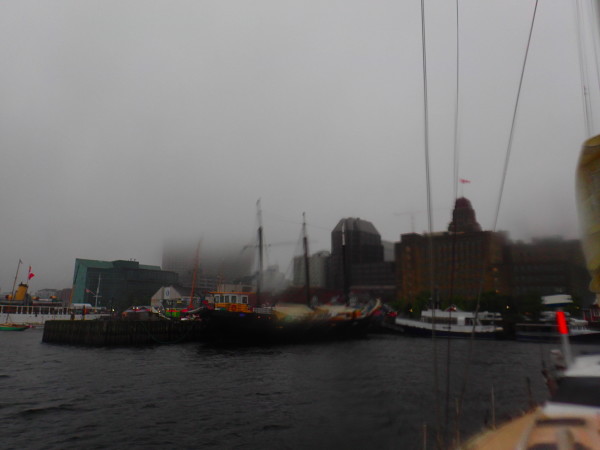
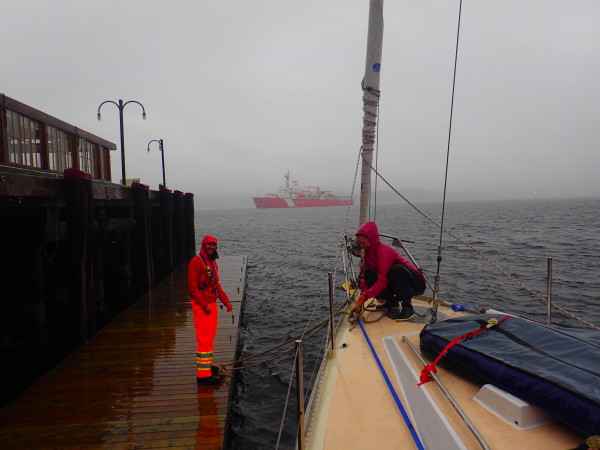
We had 2 main issues with the engine on the way to Halifax; the filters were blocking up and the propeller was vibrating. So we decided to go dry and change the propeller. Joe spent 2 days in the engine room cleaning and fine-tuning. When we left everything worked well!


After doing the last shopping for 3 months and finishing the final preparation we headed for Greenland.

Halifax to Greenland

2 days north of Halifax just off the coast of Newfoundland problems struck! Our steering wheel disconected from the rudder. It sounds serious and it is, but we were lucky that our auto-pilot still worked. We changed course and headed straight for the nearest town, Stephenville, Newfoundland where we made anchor the next morning. It took 5 days for a new part to be sent to this small isolated town and during this time we got to know some of the locals. The most generous of them was the mayor of the town who lent us a car and took us out to dinner Newfoundland style!
 The passage from Newfoundland was fast with following winds all the way. Lots of fog and the first iceberg just off Nuuk, Greenland’s capital.
The passage from Newfoundland was fast with following winds all the way. Lots of fog and the first iceberg just off Nuuk, Greenland’s capital.

Always exciting to see your first ice berg on a trip!
In Nuuk we met the first of the other arctic explorers. The yellow yacht went right up to 80°North at the top of Greenland and wintered over.

We spent 5 days in Greenland waiting for a part to be shipped up. Luckily it wasn’t important as it never arrived. The day before we set off we got the surprising news that the first 3 yachts had made it through Bellot Strait. If you like, this is the crux of the whole Northwest Passage and this was very early in the season for it to open. Some years it never does so this was good news. However we were still worried as some years it only opens for a day… Had we already missed our chance?
Up until this point it had been our warm-up and familiarization with The Hawk. Joe, Shanan and Jeremie and we always saw Greenland as the last place we could pull out if we had major safety concerns. At this point we were confident in the crew and yacht and were all happy to go on. Greenland it would be over a month before we would get another shower and go to a shop that wasn’t crazy over priced. Also from here we were on our own, if something serious happened to the yacht or one of us then rescue would be days away. And to me it was important to know the yacht well enough that if the worst was to happen to Joe the captain we could get The Hawk to the nearest port.

Greenland to Pond Inlet
We sailed up the west coast of Greenland to a place called Disco Bay, home of the ice bergs. We were had to get used to tacking through the bergs avoiding the down wind area where the small chunks or ice, (growlers) would sit, just on the surface of the water. These chunks of ice the size of cars pose the largest threat to us as they are hard to sea especially in rougher conditions. Large burgs are easy to avoid. We were reasonably confident that the Hawk with 8mm of aluminium and extra strengthening in the bow could hit one of these pieces without putting a whole in the hull, but we weren’t keen to try out that theory!
Oh by the way, for anyone heading to Greenland to see the Aurora Borealis, The Northern Lights check out This Link for all you need to know!

It was getting very cold at nights by now.
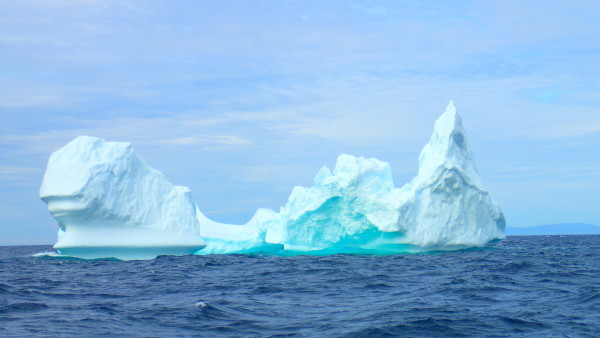
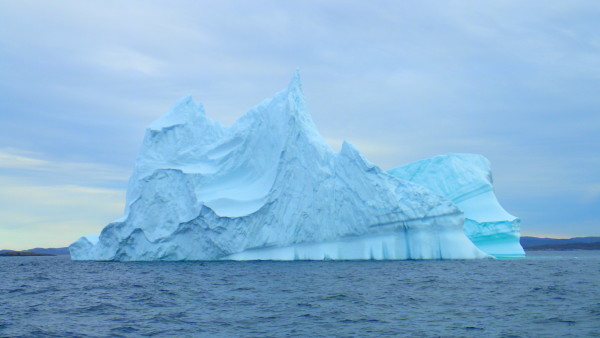




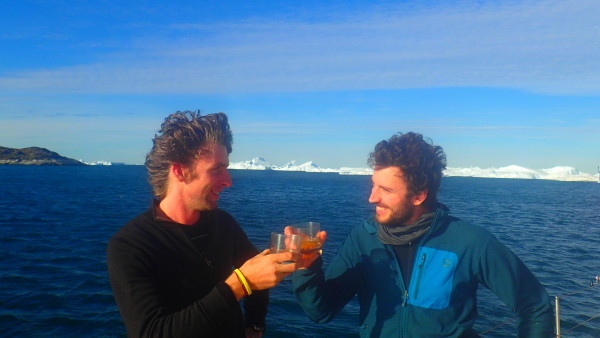


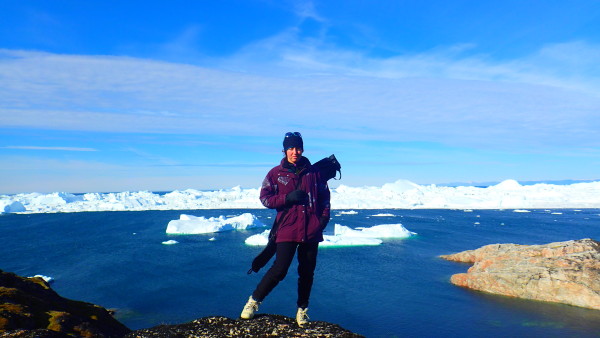




Disco bay was one of the most incredible places I have ever been. The Illulisat Ice Fiord is a massive Fiord that is completely full of ice burgs that have calved of the glacier at the edge of the Greenland Ice Cap. This video shows the witnessing of the largest ever calving event caught on camera.



We spent 4 hours motoring through the ice looking for a way into the town of Illulisat itself. There wasn’t a breath of wind, completely magical. We watched a local seal hunter shoot a seal from 90m in his small fiber glass boat with 200HP motor on the back. I was navigating form the top of the mast for 3 hours and eventually we found a way into the town. Its a crazy little harbor with hundreds of small seal hunting boats, some even have harpoons for hunting whales. Its normal to buy whale or seal in the meat markets here, its just a way of life. We certainly saw a lot of seals and great cod fishing.



Up the mast navigating through the ice




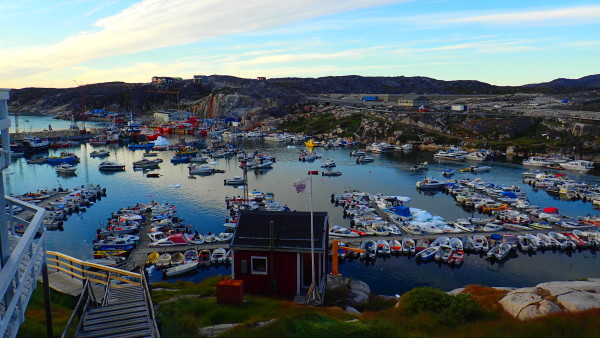
Illulisat boat harbour
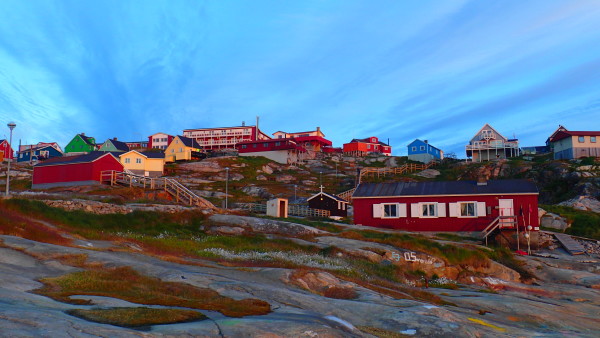
We decided to stop for some fishing the next day. The hardest thing was usually finding somewhere shallow enough to fish in Greenland so we stopped at a place very close to shore 60m deep. Shanan had never caught a fish before so she dropped down a cod jig with 5 hooks. Instantly she got a fish on and began to pull it up. She complained it was too heavy and we gave her heaps for not being stronger pulling this fish up. Anyway it turns out she had 5 large cod out of 5 hooks!! Beginners luck certainly played it part there!!



One last Ice Berg photo from Disco Bay
Our first stop in the Canadian Arctic was Pond Inlet, a small Inuit community in Navy Board Inlet at the top of Baffin Island. We stopped everywhere we could for fuel and this was a must. With no doc we had to fill Jerry cans on the beach from the tanker and do loads in the zodiac back to The Hawk . This was never much fun and would take an hour of 2. The Canadian Arctic town were all quite messy and nothing like the Greenland villages. Sadly most of the Inuit culture in this part anyway is gone. They still hunt and fish but only as a secondary food source after the supermarket that sells american junk food for crazy prices. One lady i saw paid $200 for one normal sized box of groceries. While walking around these towns its not uncommon to see polar bear or caribou skins hanging out to dry. Anything that moves is fair game for them up there.


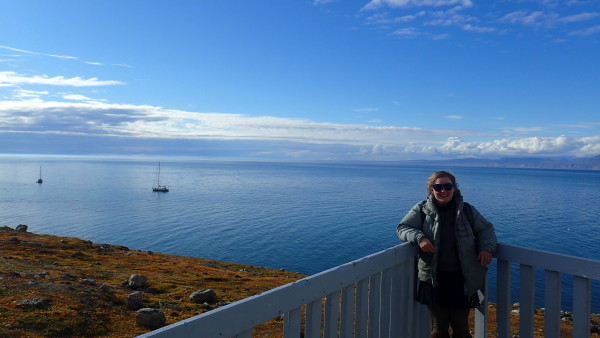
We continued through Lancaster sound to Beachey Island, the wintering over sight for the lost Franklin Expedition in the 1800s. Here we saw what we had longed to see….the little white dot on the shore that turns into a Polar Bear!! There were 2 of them and we took pictures from the safety of the zodiac. Its hard to hide for them when there’s no ice around. We expected to be navigating through ice at this point but had hardly seen any.

Pond Inlet to Gjoa Haven


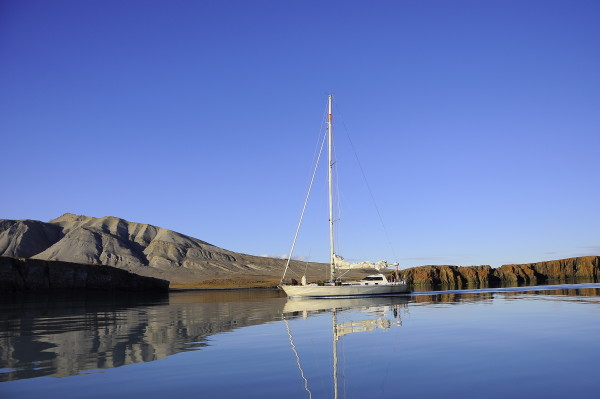

Polar Bear Tracks!
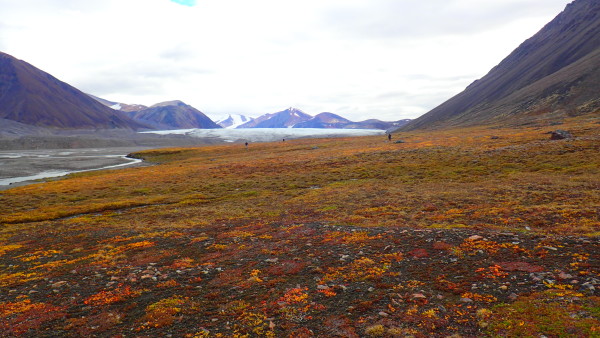
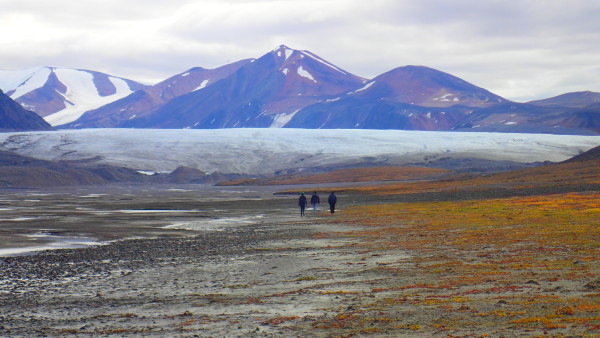
Tay Bay.


Some of the graves left from the Franklin expedition. The people were dying from lead poisoning from the lead solder around the tins of food.

This brings back memory’s. A postcard from the Kapitan Khlebnikob that I spent 2 month on in Antarctica

The time captuals with notes form previous visits inside

The remains of the hut the Franklin Expedition wintered over in.


Our farthest north
From Beachey Island we headed south down Peel Sound. Usually this is hard to navigate through due to heavy ice but we only encountered some old rotten flows that were all but melted. We downloaded an ice chart each day via the sat phone so we could always see where the ice was and how fast its moving. You never get between a large area of ice and the shore. If you got stuck in the ice your in huge trouble.

At Bellot straight since there was no ice to be seen we decided to go through to visit the historical sight Fort Ross, an old Hudson Bay Trading Post hut. Bellot straight is 17 miles long and less than a mile wide and at one point there’s a submerged rock on one side and shoal on the other, leaving a channel no more than 200m wide. At this point the current reaches 6 knots so you must go with the tide and there’s no turning around once your in there!! We came back through to the west side of Bellot straight on the next tide after visiting Fort Ross. This is a dangerous channel and we took extreme caution.

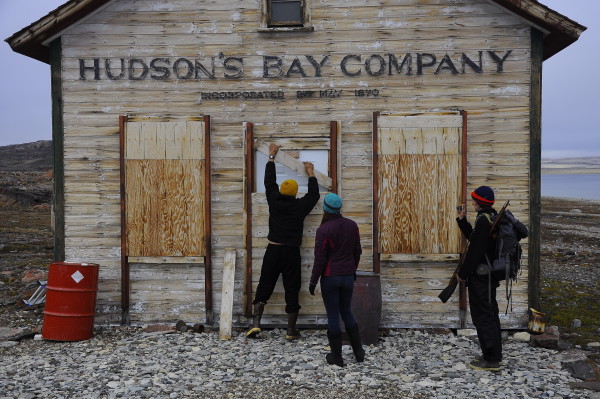








For the week from Greenland to Gjoa Haven we had the most spectacular weather through what is certainly the best part of the passage. Everyday we got to land and make the most of where were. Gjoa Haven is an other small Inuit village in a very nice harbor on King William Island. Its named after Ronald Amundsen‘s ship The Gjoa. Amundsen spent 2 winters in this harbor in 1901-03 and went on to complete the first transit of the north West Passage.


Arctic Char hanging out to dry in the cold dry air and it will be saved for the winter

Gjoa Haven
From here we got a moderate weather system come behind us and with consistent 25-30 knots we got pushed through to Tuktoyaktuk in 8 days. When you doing passages like this life is very simple. You do your watch, and sleep. That all. There’s not such to do on a 12m boat for 8 days. You certainly cant go for a walk!

Gjoa Haven to Tuk

Halfway between Gjoe Haven and Tuk we had an uncontrolled gybe. I was steeping and was the scariest moment of the trip for me. An uncontrolled gybe is when the main sail gets a gust of wind behind it as swings from one side of the yacht to the other with a deafening crack. Things can break, and if your in the way of the boom you could easily be killed or knocked overboard. To prevent this happening you had a preventer on whenever your sailing downwind. This is a rope going opposite to the main sheet to stop the boom from swinging across. On this particular day our preventer broke causing this accident. We were incredibly lucky noting serious happened. We did however badly damage out track where the main sheet connects to the top of the dodger. We had to improvise and re connect the main sheet to a sturdy hand rail on the top of the dodger and this took us all the way to Kodiak, Alaska.


Just before Tuk we went past the Smoking Hills. These are coal seams that have been burning for 100s of years


When we arrived in Tuk we really wanted to stop for a day or two as we had been at sea for 8. However the weather forecast was changing from following winds to head winds in the next day and if we stopped it would mean loosing our awesome weather window to get to Nome, Alaska. We decided to stop for 2 hours to get fuel and water and then leave. It was the hardest thing to get back on The Hawk and sail away from the land we so longed to stay on for a day. Here we met the first of the other yachts that were transiting the passage in front of us and we longed to exchange story’s. This weather window was good though and it pushed us across the top of Alaska and down through the Bering Straight, a treacherous piece of water where you can see Alaska and Russia at the same time. Here we again had up to 45 knots of wind, this time however it was behind us but the sea was large and ugly. The poor Hawk got thrown around but handled it well. We had just our stay sail up and still we would get blown over to 50 degrees with gusts of wind 40+ knots. Each night we would see the northern lights in the sky above us. Usually it was a bit cloudy but one particular night it was right across the sky at 4am with a crescent moon and if you put your face outside the cockpit you would get a cold face full of high speed spray! Raw nature at its best and another moment I will never forget. Here we crossed the Arctic Circle ending our successful 31 day transit of the North West Passage. Now you just have to get through the Bering sea, one of the worst oceans on earth.

Tuk to Nome





We finally got to stop at Nome, Alaska, and it was amazing to be back on land at last after 14 days at sea. We had our first shower in 5 weeks and got to share our story’s with 5 other yachts who had also jut completed the passage. Among these were SV Salty Kisses, Selma Expeditions from Poland, Baghera Sailing and Snow Dragon. When we got bored there was always something happening at the gold-miner’s bar in central Nome!

The other yachts that transited the passage in front of us. From left, Salty Kisses, Bahera, Snow Dragon, SV Hawk, and french yacht.

A gold dredge in Nome harbor
4 days in Nome later and the weather gods looked down on us again and gave us following winds through the Bering Sea. We were so lucky as this had been a big worry for us. By now it was mid September and by October this ocean can be no mans land.

Nome to Kodiak

3 days later we rounded the western end of the Alaskan Peninsular and were on the home straight to Kodiak. Our second last night we anchored up in Geographic harbor in Katmai National Park for the night. Here we got to see 10 grizzly bears fishing for salmon in the river the next morning, a magical sight.












One last nigh at anchor just out of Kodiak and before we knew it we were in the crazy little fishing harbor in Kodiak. Joe’s home town. We were treated like celebrity’s by the locals who all wanted to hear our story’s, see our pictures and they invited up out every night for dinner and drinks. An amazing way to finish of a trip of a life time with such fun happy people.

July 20th to September 22nd
7000 miles
Percentage of trip Sailing/motoring: 35% motoring, 35% Sailing, 30% Motor Sailing,
Ports of call: 9
Nights at Anchor: 5
Time to complete traditional North West Passage route 2: 31 days
Other vessels seen transiting North West Passage: 13
The last month and a half of food supply’s got distributed around to all the locals. We packed up The Hawk and put her to bed in Dog Harbor where she will sit the winter out. Joe has plans to sail around Alaska with her and when he gets sick of that probably further afield again. SV hawk was certainly an amazing yacht, very strong, very simple, and with the exception of the steering wheel and the preventer nothing ever broke on the rest of the voyage.
It amazes me that 5 people who didn’t really know each other can spend 3 months on a yacht and come away best friends. We all left with a sense of achievement, remembering that only 135 yachts have ever successfully sailed those water’s and we earn’t our place on that list. We are now all experienced sailors and hope to go on other sailing adventures in the future. Having this experience it opens opportunities to do similar trips and get paid along the way. Joe taught us well and wasn’t a commanding captain, but more of a equal who would step in when needed. This gave us the incredible opportunity to step up, take charge and learn everything about running a yacht. Invaluable experience!!

5 Comments
Amazing journey. Was it difficult avoiding the floating ice?
[…] συγκεκριμένα είτε περνάτε από τη Γροιλανδία ενώ πλέοντας το Βορειοδυτικό Πέρασμαείναι δυνατό να επισκεφθείτε και να δείτε το βόρειο […]
A great diary of an exceptional voyage.
Thank you for sharing!
Very nice description!
I hope to run into you guy’s again some day!
All the best
Jim
Wow, what an adventure! Great photos.:) Keep the posts coming please!